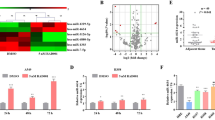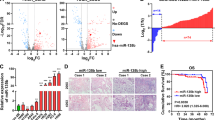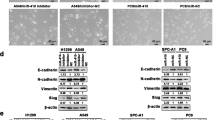Abstract
The dual role of the microRNA-29 (miR-29) family in tumor progression and metastasis in solid tumors has been reported. Evidence for the role of miR-29 in tumor malignancy and its prognostic value in overall survival (OS) and relapse-free survival (RFS) in non-small cell lung cancer (NSCLC) remains conflicting. Mechanistic studies presented herein demonstrated that c-Myc suppressed the expression of miR-29b, promoting soft agar growth and invasion capability in lung cancer cells. Interestingly, the decrease in the expression of miR-29b by c-Myc is responsible for soft agar growth and invasiveness mediated by FHIT loss due to promoter methylation. Among patients, low expression of miR-29b and FHIT was more common in tumors with high c-Myc expression than in tumors with low c-Myc expression. Kaplan–Meier and Cox regression analysis showed that tumors with high c-Myc, low miR-29b and low FHIT expression had shorter OS and RFS periods than their counterparts. In conclusion, the decrease in the expression of miR-29b by c-Myc may be responsible for FHIT loss-mediated tumor aggressiveness and for poor outcome in NSCLC. Therefore, we suggest that restoration of the miR-29b expression using the c-Myc inhibitor might be helpful in suppressing tumor aggressiveness mediated by FHIT loss and consequently improving outcomes in NSCLC patients with tumors with low expression of FHIT.
This is a preview of subscription content, access via your institution
Access options
Subscribe to this journal
Receive 50 print issues and online access
$259.00 per year
only $5.18 per issue
Buy this article
- Purchase on Springer Link
- Instant access to full article PDF
Prices may be subject to local taxes which are calculated during checkout





Similar content being viewed by others
References
Xiong Y, Fang JH, Yun JP, Yang J, Zhang Y, Jia WH et al. Effects of microRNA-29 on apoptosis, tumorigenicity, and prognosis of hepatocellular carcinoma. Hepatology 2010; 51: 836–845.
Fabbri M, Garzon R, Cimmino A, Liu Z, Zanesi N, Callegari E et al. MicroRNA-29 family reverts aberrant methylation in lung cancer by targeting DNA methyltransferases 3A and 3B. Proc Natl Acad Sci USA 2007; 104: 15805–15810.
Li Y, Wang F, Xu J, Ye F, Shen Y, Zhou J et al. Progressive miRNA expression profiles in cervical carcinogenesis and identification of HPV-related target genes for miR-29. J Pathol 2011; 224: 484–495.
Yu PN, Yan MD, Lai HC, Huang RL, Chou YC, Lin WC et al. Downregulation of miR-29 contributes to cisplatin resistance of ovarian cancer cells. Int J Cancer 2013; 134: 542–551.
Rothschild SI, Tschan MP, Federzoni EA, Jaggi R, Fey MF, Gugger M et al. MicroRNA-29b is involved in the Src-ID1 signaling pathway and is dysregulated in human lung adenocarcinoma. Oncogene 2012; 31: 4221–4232.
Plaisier CL, Pan M, Baliga NS . A miRNA-regulatory network explains how dysregulated miRNAs perturb oncogenic processes across diverse cancers. Genome Res 2012; 22: 2302–2314.
Gebeshuber Braconi C, Kogure T, Valeri N, Huang N, Nuovo G, Costinean S et al. microRNA-29 can regulate expression of the long non-coding RNA gene MEG3 in hepatocellular cancer. Oncogene 2011; 30: 4750–4756.
Gebeshuber CA, Zatloukal K, Martinez J . miR-29a suppresses tristetraprolin, which is a regulator of epithelial polarity and metastasis. EMBO Rep 2009; 10: 400–405.
Kong G, Zhang J, Zhang S, Shan C, Ye L, Zhang X . Upregulated microRNA-29a by hepatitis B virus X protein enhances hepatoma cell migration by targeting PTEN in cell culture model. PLoS ONE 2011; 6: e19518.
Jin B, Robertson KD . DNA methyltransferases, DNA damage repair, and cancer. Adv Exp Med Biol 2013; 754: 3–29.
Lee YC, Wu CT, Shih JY, Jou YS, Chang YL . Frequent allelic deletion at the FHIT locus associated with p53 overexpression in squamous cell carcinoma subtype of Taiwanese non-small-cell lung cancers. Br J Cancer 2004; 90: 2378–2383.
Kim JS, Kim H, Shim YM, Han J, Park J, Kim DH . Aberrant methylation of the FHIT gene in chronic smokers with early stage squamous cell carcinoma of the lung. Carcinogenesis 2004; 25: 2165–2171.
Wang J, Cheng YW, Wu DW, Chen JT, Chen CY, Chou MC et al. Frequent FHIT gene loss of heterozygosity in human papillomavirus-infected non-smoking female lung cancer in Taiwan. Cancer Lett 2006; 235: 18–25.
Yoon SO . Abnormal fragile histidine triad (Fhit) expression in invasive cervical adenocarcinoma: association with tumor aggressiveness. Hum Pathol 2007; 38: 326–331.
Connolly DC, Greenspan DL, Wu R, Ren X, Dunn RL, Shah KV et al. Loss of fhit expression in invasive cervical carcinomas and intraepithelial lesions associated with invasive disease. Clin Cancer Res 2000; 6: 3505–3510.
Butler D, Collins C, Mabruk M, Barry Walsh C, Leader MB, Kay EW . Deletion of the FHIT gene in neoplastic and invasive cervical lesions is related to high-risk HPV infection but is independent of histopathological features. J Pathol 2000; 192: 502–510.
Chang TC, Yu D, Lee YS, Wentzel EA, Arking DE, West KM et al. Widespread microRNA repression by Myc contributes to tumorigenesis. Nat Genet 2008; 40: 43–50.
Mott JL, Kurita S, Cazanave SC, Bronk SF, Werneburg NW, Fernandez-Zapico ME . Transcriptional suppression of mir-29b-1/mir-29a promoter by c-Myc, hedgehog, and NF-kappaB. J Cell Biochem 2010; 110: 1155–1164.
Gong JN, Yu J, Lin HS, Zhang XH, Yin XL, Xiao Z et al. The role, mechanism and potentially therapeutic application of microRNA-29 family in acute myeloid leukemia. Cell Death Differ 2014; 21: 100–112.
Zhang X, Zhao X, Fiskus W, Lin J, Lwin T, Rao R et al. Coordinated silencing of MYC-mediated miR-29 by HDAC3 and EZH2 as a therapeutic target of histone modification in aggressive B-Cell lymphomas. Cancer Cell 2012; 22: 506–523.
McMurray HR, McCance DJ . Human papillomavirus type 16 E6 activates TERT gene transcription through induction of c-Myc and release of USF-mediated repression. J Virol 2003; 77: 9852–9861.
Xu M, Katzenellenbogen RA, Grandori C, Galloway DA . NFX1 plays a role in human papillomavirus type 16 E6 activation of NFkappaB activity. J Virol 2010; 84: 11461–11469.
James MA, Lee JH, Klingelhutz AJ . Human papillomavirus type 16 E6 activates NF-kappaB, induces cIAP-2 expression, and protects against apoptosis in a PDZ binding motif-dependent manner. J Virol 2006; 80: 5301–5307.
Pylkkanen L, Wolff H, Stjernvall T, Tuominen P, Sioris T, Karjalainen A et al. Reduced Fhit protein expression and loss of heterozygosity at FHIT gene in tumours from smoking and asbestos-exposed lung cancer patients. Int J Oncol 2002; 20: 285–290.
Burke L, Khan MA, Freedman AN, Gemma A, Rusin M, Guinee DG et al. Allelic deletion analysis of the FHIT gene predicts poor survival in non-small cell lung cancer. Cancer Res 1998; 58: 2533–2536.
Maruyama R, Sugio K, Yoshino I, Maehara Y, Gazdar AF . Hypermethylation of FHIT as a prognostic marker in nonsmall cell lung carcinoma. Cancer 2004; 100: 1472–1477.
Pavelic K, Krizanac S, Cacev T, Hadzija MP, Radosevic S, Crnic I et al. Aberration of FHIT gene is associated with increased tumor proliferation and decreased apoptosis-clinical evidence in lung and head and neck carcinomas. Mol Med 2001; 7: 442–453.
Tomizawa Y, Nakajima T, Kohno T, Saito R, Yamaguchi N, Yokota J . Clinicopathological significance of Fhit protein expression in stage I non-small cell lung carcinoma. Cancer Res 1998; 58: 5478–5483.
Tseng JE, Kemp BL, Khuri FR, Kurie JM, Lee JS, Zhou X et al. Loss of Fhit is frequent in stage I non-small cell lung cancer and in the lungs of chronic smokers. Cancer Res 1999; 59: 4798–4803.
Kim JS, Kim JW, Han J, Shim YM, Park J, Kim DH . Cohypermethylation of p16 and FHIT promoters as a prognostic factor of recurrence in surgically resected stage I non-small cell lung cancer. Cancer Res 2006; 66: 4049–4054.
Wu DW, Tsai LH, Chen PM, Lee MC, Wang L, Chen CY et al. Loss of TIMP-3 promotes tumor invasion via elevated IL-6 production and predicts poor survival and relapse in HPV-infected non-small cell lung cancer. Am J Pathol 2012; 181: 1796–1806.
Wu MF, Cheng YW, Lai JC, Hsu MC, Chen JT, Liu WS et al. Frequent p16INK4a promoter hypermethylation in human papillomavirus-infected female lung cancer in Taiwan. Int J Cancer 2005; 113: 440–445.
Cheng YW, Wu MF, Wang J, Yeh KT, Goan YG, Chiou HL et al. Human papillomavirus 16/18 E6 oncoprotein is expressed in lung cancer and related with p53 inactivation. Cancer Res 2007; 67: 10686–10693.
Okuyama H, Endo H, Akashika T, Kato K, Inoue M . Downregulation of c-MYC protein levels contributes to cancer cell survival under dual deficiency of oxygen and glucose. Cancer Res 2010; 70: 10213–10223.
Jamerson MH, Johnson MD, Dickson RB . Dual regulation of proliferation and apoptosis: c-myc in bitransgenic murine mammary tumor models. Oncogene 2000; 19: 1065–1071.
Napoli C, Lerman LO, de Nigris F, Sica V . c-Myc oncoprotein: a dual pathogenic role in neoplasia and cardiovascular diseases? Neoplasia 2002; 4: 185–190.
Robson S, Pelengaris S, Khan M . c-Myc and downstream targets in the pathogenesis and treatment of cancer. Recent Pat Anticancer Drug Discov 2006; 1: 305–326.
Wolfer A, Ramaswamy S . MYC and metastasis. Cancer Res 2011; 71: 2034–2037.
Wu DW, Cheng YW, Wang J, Chen CY, Lee H . Paxillin predicts survival and relapse in non-small cell lung cancer by microRNA-218 targeting. Cancer Res 2010; 70: 10392–10401.
Kristensen LS, Mikeska T, Krypuy M, Dobrovic A . Sensitive meltings analysis after real time- methylation specific pcr (smart-msp): high-throughput and probe-free quantitative dna methylation detection. Nucleic Acids Res 2008; 36: e42.
Treppendahl MB, Qiu X, Sogaard A, Yang X, Nandrup-Bus C, Hother C et al. Allelic methylation levels of the noncoding VTRNA2-1 located on chromosome 5q31.1 predict outcome in AML. Blood 2012; 119: 206–216.
Acknowledgements
This work was jointly supported by grants from the National Health Research Institute (NHRI96-TD-G-111-006; NHRI97-TD-G-111-006) and the National Science Council(100-2314-B-038-043-MY3) of Taiwan, ROC.
Author information
Authors and Affiliations
Corresponding author
Ethics declarations
Competing interests
The authors declare no conflict of interest.
Additional information
Supplementary Information accompanies this paper on the Oncogene website
Supplementary information
Rights and permissions
About this article
Cite this article
Wu, DW., Hsu, NY., Wang, YC. et al. c-Myc suppresses microRNA-29b to promote tumor aggressiveness and poor outcomes in non-small cell lung cancer by targeting FHIT. Oncogene 34, 2072–2082 (2015). https://doi.org/10.1038/onc.2014.152
Received:
Revised:
Accepted:
Published:
Issue Date:
DOI: https://doi.org/10.1038/onc.2014.152
This article is cited by
-
Prospects of microRNAs as therapeutic biomarkers in non-small cell lung cancer
Medical Oncology (2023)
-
Germinal epimutation of Fragile Histidine Triad (FHIT) gene is associated with progression to acute and chronic adult T-cell leukemia diseases
Molecular Cancer (2021)
-
PESV represses non-small cell lung cancer cell malignancy through circ_0016760 under hypoxia
Cancer Cell International (2021)
-
CDK7 inhibitor THZ1 enhances antiPD-1 therapy efficacy via the p38α/MYC/PD-L1 signaling in non-small cell lung cancer
Journal of Hematology & Oncology (2020)
-
MiR-596 activated by EP300 controls the tumorigenesis in epithelial ovarian cancer by declining BRD4 and KPNA4
Cancer Cell International (2020)



